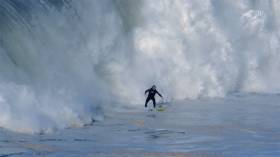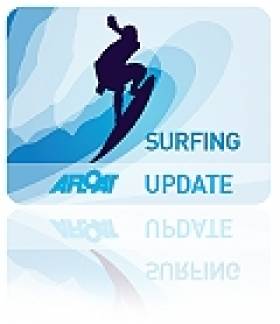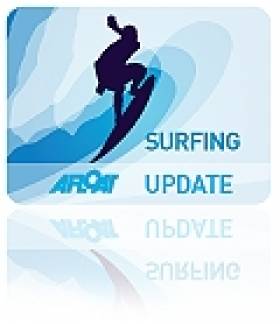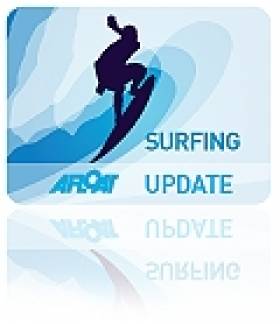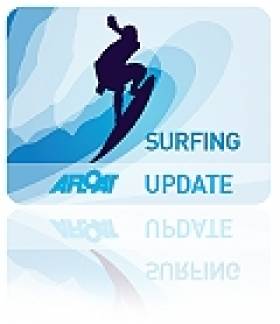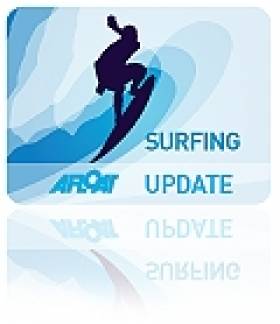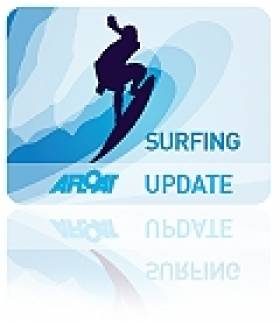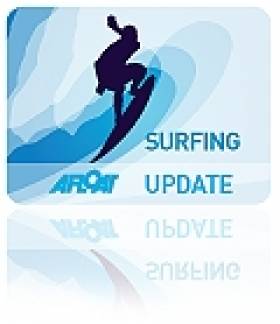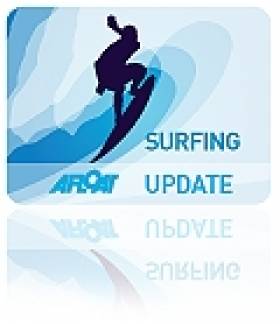Displaying items by tag: Andrew Cotton
Surfing Daredevil Andrew ‘Cotty’ Cotton Returns from Broken Back to Take On World’s Largest Waves
Four years after breaking his back when he wiped out surfing the massive swell at Nazaré, a British big wave rider has returned to Portugal conquer his demons, as Metro reports.
Andrew ‘Cotty’ Cotton was a regular at Ireland’s surfing hot spots like Mullaghmore Head before the fateful attempt to ride the infamous wall of water at Praia do Norte in November 2017 that left him with a serious spinal injury.
But the Devon man, now 39, was determined to heal and return to surfing fitness. He was back at Nazaré last year just three years after his potentially life-changing injury.
And this year he’s staying in Portugal for the big wave season, with a view to catching another 80-footer that could mean a place in the record books.
Metro has more on the story HERE.
New Big Wave Hotspot Discovered Off Irish Coast
#Surfing - Chasing the most challenging swells is the dream of the world's top big wave surfers, who've made an art of determining where the tallest walls of water can be found.
But now one Irish coastal regular reveals how he turned to science for his discovery of a new secret hotspot off the North West.
As Mail Online reports, Andrew 'Cotty' Cotton consulted with weather analysts and oceanographers in poring over satellite data to find the offshore sweet spot – generating waves that averaged some nine metres, or 30 feet – after the stormy winter of late 2014.
However, the Devon surfer believes the location could produce swells more than twice that size – and may even break the record for the biggest wave ever surfed as set at Nazaré in Portugal by Garrett McNamara in 2013.
Cotty's quest is the subject of a new documentary on RedBull.tv, while Mail Online has much more on the story HERE.
Cotty Gets Big Wave Nomination For Storm Rachel Giant At Mullaghmore
#Surfing - Mullaghmore regular Andrew 'Cotty' Cotton has secured a nomination in the 2015 Billabong XXL Big Wave Awards for his monster ride on the swells that preceded Storm Rachel this week.
According to The Irish Times, Cotty skipped an appointment with his chiropractor to race from his Devon home to the Sligo coast a week ago to make the most of the strengthening surf.
Shaking off the effects of a shoulder injuring sustained while surfing at the infamous Praia do Norte in Portugal last month, he was ready to take advantage on Monday.
That's when the waves reached their peak in the midst of an "exceptional" five days of surf to match or even better the Vikings storm of 2012.
And luckily for us, it was all caught on video for a new documentary on his and other big wave surfers' adventures on the edge.
The Irish Times has more on the story HERE.
'Victory At Sea' As Surfer Cotty Awaits Biggest Wave Record Confirmation
#Surfing - Mullaghmore regular Andrew Cotton is waiting to hear if he has snagged the world record for surfing the biggest wave in recorded history.
As the video above shows, Devon surfer Cotty was simply dwarfed by the giant swell off Nazare in Portugal on Sunday 2 February, in the same location where friend and rival Garrett McNamara clinched the world record in November 2011.
Just a month ago Cotty was tackling 50-foot waves off the Sligo coast - and as Surfer Today reports, he's now claiming "victory at sea" after surfing what the UK media is calling an 80-foot monster wave.
But we'll still have to wait and see if the record is made official.
Cotty Gets Big Surf On Camera Off Mullaghmore
#Surfing - Devon surfer Andrew Cotton, a regular at Ireland's big wave hotspots, was spoilt for choice as the 'black swell' moved in on the coastlines of Western Europe earlier this week.
But as the video above shows, he plucked for the walls of water off Mullaghmore Head in Co Sligo.
And according to the Daily Telegraph, Cotty was not at all disappointed, catching waves of up to 50 feet charged by the exceptional Atlantic swell - and getting it all on camera for a documentary series on adventure sports web broadcaster EpicTV.
As previously reported on Afloat.ie, the stormy conditions brought surfers in their hundreds to Ireland's west coast to catch the biggest waves going.
Easkey Britton Praises New Account of Surfing in Ireland
#SURFING - A new book that delves into the world of surfing in Ireland gets a thumbs-up review from surf pro Easkey Britton in The Irish Times.
Cliffs of Insanity, by Irish Times sportswriter Keith Duggan, focuses on the close-knit surfing community in Lahinch, Co Clare - one of the many hotspots along the west coast that have produced such Irish big wave sensations as Ollie O'Flaherty and overseas visitors like Devon's Andrew Cotton (featured in the video above).
Britton - in the news herself recently for her pioneering surf trip to Iran - notes the passion among Ireland's surfers "to pursue a challenging vocation, one that is raw and unglamorous, set against the icy waters of the Atlantic" towered over by the Cliffs of Moher - the 'cliffs of insanity' of the title.
She also describes the book's central story - the progress of Mayo man Fergal Smith and Cornwall native Mickey Smith as they surf the uncompromising Aileens break - as "a story of hope for an island nation on its knees".
"Duggan presents a rare and intimate window into a little-understood world," she writes. "The ocean and the art of wave riding run so deep in our veins that when you ask a surfer to describe what it feels like we struggle to put it into words."
The Donegal surfing star adds that Duggan "is uniquely positioned as an 'outsider' looking in, and he captures what it is that drives these surfing souls, describing it as 'an elemental pull'."
The Irish Times has more on the story HERE.
'One Epic Day of Huge Surf' Caught On Film
#SURFING - A new short film tells the story of "one epic day of huge surf" at Mullaghmore Head, as Surfer Today reports.
The Northcore film 'Fathoms Left to Fall' follows some of the world's top big wave surfers as they converged on Co Sligo to take advantage of the swell, prompted by the extreme weather system known as the 'Viking storm'.
Among the Irish riders featured is 24-year-old Ollie O'Flaherty, who has been nominated for the 'biggest wave' prize in the 2012 Billabong XXL Big Wave Awards for his monster ride at Mullaghmore.
Also nominated for his outstanding effort at the Sligo surf mecca is Andrew Cotton, a Devon native who's no stranger to Ireland's big rollers.
Irish Surfer Needs Funds to Attend Big Wave Awards
#SURFING - A young surfer from Lahinch in Co Clare is in the running for the 'biggest wave' prize in the 2012 Billabong XXL contest for his monster ride at Mullaghmore Head, The Irish Times reports.
Ollie O'Flaherty, 24, is nominated along with Devon's Andrew Cotton for the massive surf they caught off Co Sligo on 8 March last.
It was the first visit to the world-class big wave spot by O'Flaherty, a science student at NUI Galway who is a veteran of the Co Clare scene.
As previously reported on Afloat.ie, it was Cotton who tackled the biggest wave on that day - a giant 50-footer - as some of the world's top surfers took advantage of the Viking swell.
Also nominated for the $50,000 (€38,280) prize is Irish-American surfer Garrett McNamara, who last year rode what is being called the biggest wave ever surfed in the world, a 90-foot goliath off Nazaré in Portugal.
According to the Irish Independent, O'Flaherty has put out a call for sponsorship so he can attend the awards ceremony next month.
"It's a massive honor to be able to represent Ireland," he said, but added that he is "pretty much on the breadline from what I'm doing".
Should he win, the Lahinch native said he intends to "put every cent back into surfing" and replace his seven broken boards.
The winners will be announced at the Billabong XXL Big Wave Awards in Anaheim, California on 4 May.
Top Surfers Tackle Biggest Rollers in Years Off Mullaghmore
#SURFING - It may have been too late for the postponed Tow-In Surf Session, but the big waves at Mullaghmore Head finally picked up this week - and some of the world's top surfers were there to take advantage of the swell.
As The Irish Times reports, an extreme weather system nicknamed the 'Viking storm' helped produced monster rollers on Thursday that are the biggest the area has seen in 15 years.
Devon surfer Andrew 'Cotty' Cotton rode the biggest wave when he tackled a 50ft giant, assisted by his Irish tow-in partner Al Mennie, while Brit boarder Tom Butler recorded the biggest barrel.
Richie Fitzgerald described the scene as "very calculated madness", noting that a safety crew was on hand as the 16-strong group took on the "huge, unruly and very dangerous swell".
The Irish Times has much more on the story, while Surfer Today has more video of the last winter swell at Mullaghmore Head HERE.
'World's Biggest Waves' Off Irish Coast?
#SURFING - One of Ireland's top surfers claims he has found the world's biggest waves off the coast of Ireland.
As Irish Central reports, Portrush waverider Al Mennie says that he and surfing partner Andrew Cotton have found two waves reaching as much as 120 feet in secret locations off the coasts of Antrim and Donegal.
The duo are currently waiting for the right conditions to surf the biggest swells.
"The good days are few and far between – 90 percent of the swells are unrideable and we'd reckon that only two days each year are rideable," Mennie told the Irish Independent.
Their location is being kept under wraps for now due to safety concerns, as the waves crash down in a hazardous rocky area - making them definitely not suitable for novices.
Irish Central has more on the story HERE.



























